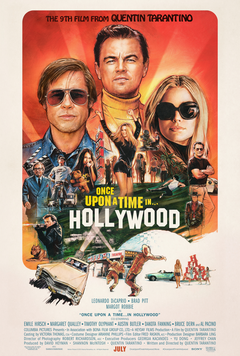Once Upon a Time…in Hollywood


Once Upon a Time…in Hollywood
Release Date: July 26, 2019
Runtime: 161 minutes
Rating: R
Studio: Columbia Pictures
Director: Quentin Tarantino
Cast: Leonardo DiCaprio; Brad Pitt; Margot Robbie; Al Pacino; Kurt Russell; Margaret Qualley; Dakota Fanning; Luke Perry; Timothy Olyphant; Emile Hirsch; Bruce Dern
**Possible Spoilers**
Quentin Tarantino’s latest sees the director indulging in his affection for the Hollywood of his early youth, and the result is an enormously entertaining, fantastically performed consideration of love, loss, and the uncertainly of the future.
One will immediately notice that the most impressive attribute of Once Upon a Time…in Hollywood (OUATIH) is the production itself: the painstaking and uncanny manners in which Tarantino redresses modern Hollywood to recreate 1969 Hollywood. In a film like OUATIH, setting and time is crucial, and the director and his production team (production designer Barbara Ling; set decorator Nancy Haigh; costume designer Arianne Phillips; among other below the liners) do a remarkable job of transporting the audience to the not-so-distant past, to a time when the peace and love rhetoric of the 1960s was on the precipice of destruction.
Onto this hearty tableau, Tarantino places Rick Dalton (Leonardo DiCaprio), the fading star of a once popular cowboy program (think Bonanza) struggling to come to terms with his waning career, Cliff Booth (Brad Pitt – who should absolutely receive recognition come awards season for his work here), Rick’s faithful best friend and stunt double also facing an uncertain future, and Sharon Tate (Margot Robbie – also excellent), the real-life Valley of the Dolls starlet who just happens to live (with her husband, Rosemary’s Baby director Roman Polanski) next door to Rick. In blending the factual (Sharon Tate, Jay Sebring, the Playboy Mansion, El Coyote Restaurant, etc.) and fictional (Rick Dalton, Cliff Booth, Dalton’s TV show Bounty Law, etc.), Tarantino exploits his bountiful knowledge of the entertainment industry to examine what it’s like to face one’s own professional and personal mortality. Rick, once a huge star in TV land is now forced to take a meeting with (for once, a non sleazy) agent (Al Pacino – in a brief role and thankfully, not Pacino-ing it up to the nth degree) who advises him to abandon Hollywood altogether and to go make Sergio Leone-type spaghetti westerns in Italy. Cliff, hauling the burden of a sketchy past, doesn’t have it much better; his whole life and livelihood is tethered to Rick as both his stunt double and general valet. Even the setting of the film (1969) signifies the “coming to an end”-ness that Tarantino is thematically exploring. Ironically, it is Sharon Tate (whose grisly fate is well known) who is the only character in the move who can be said to be looking towards the future with hope and excited anticipation. Her star is on the rise (a lengthy sequence touchingly accompanies Tate as she attends a Westwood screening of one of her films (the Dean Martin comedy The Wrecking Crew) and giggles proudly as the audience laughs at her klutzy character) and her marriage to Polanski has resulted in a pregnancy. Speaking of Tate, Tarantino’s reimagining of her horrific murder (as well as that of Sebring, coffee heiress Abigail Folger, and Voytek Frykowski) at the hands of members of Charles Manson’s “Family” is ingenious: the director is smart and tasteful enough not to stage a simple reenactment, but to reposition the events for his story to involve his main characters, trusting that the audience knows how the tragedy played out in real life. In approaching such a brutal event in this way, Tarantino manages to underscore the terrifying memory of the actual events of August 1969.
DiCaprio and Pitt make an inspired pair: the kind of movie star pairing that requires dual-billing in the credits and where each actor charismatically acknowledges, with that movie star twinkle, the evident star wattage they are gleefully endorsing. (This sort of movie star pairing does not always work, however, as you can see in Pitt’s own The Mexican, a lame movie in which he ostensibly costarred with Julia Roberts although the two shared minimal screen time together.) Pitt just seems to get cooler with age and at 55, his smile (and abs) is more inviting than ever. Pitt’s perpetually stoned, good-time, breezy guy persona serves Cliff well, yet there are certainly moments in OUATIH when we can sharply ascertain Pitt’s talent behind the persona. DiCaprio’s effective evocation of Rick’s career disappointment and disillusionment allows the audience to sympathize with Rick, and in a way, with all those talented actors who have tread similar roads (there is even a moment when Rick contemplates returning to his native Missouri (interestingly, Pitt’s home state) – how many actors have had that internal dialogue with themselves?) By all accounts, Sharon Tate was a wonderful and warm woman and these two adjectives couldn’t more succinctly describe Robbie’s personification of her. Tarantino and Robbie look way beyond Tate’s extraordinary beauty and expose the down-to-earth and content woman she was, further underlining the tragedy we all know is inevitable.
Tarantino uses his trademark self-conscious dialogue and over-the-top violence judiciously in OUATIH: this is no Pulp Fiction or Kill Bill. The violence in display in OUATIH is not cartoonish and the dialogue flows more naturally from the characters than say, in Pulp Fiction, where it has a more theatrical quality (although the cursing quotient remains as high as you would expect in a Tarantino movie). In OUATIH, Tarantino has made a very personal, restrained (for him), and intelligent pontification on human tragedy.

2 Comments
Such a well written revue!
Excellent review but I didn’t think the movie was that great. Loved the music and the period cars.